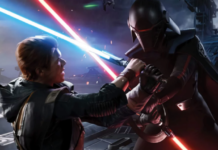Dragons, Dragons, everywhere …
from Panzer Dragoon to Divinity II
By Dan Liebman
Those fire-breathing critters
have always held a certain fascination – even in video games
You may ask yourself, “Why should I
care about dragons in video games?” The answer is simple: if you don’t, you will
be flame-broiled and eaten alive.
Millions of years before the first
gaming console was developed, our planet was dominated by strange creatures.
Some of these beasts grew to tremendous sizes, and for many years, they pretty
much ran the show. Unfortunately, their reign came to an end. By the time our
species showed up, all that remained were fossilized skeletons of an
awe-inspiring dynasty. We called these creatures “dragons.”

Today, of course, we call them
“dinosaurs,” at least when we’re trying earnestly to understand these enigmatic
organisms. But while our vision of “dinosaurs” has changed dramatically in the
past two centuries, our vision of “dragons” has remained almost untouched. A
millennia-old manuscript contains images of serpentine, winged monsters nearly
identical to those found in one of 2009’s top titles. That such an archaic image
should appear so consistent over the years is truly a testament to its power.
The traditional, western dragon is a pervasive archetype within the public
consciousness. There is no mistaking the scaly reptilian hide, menacing jaws,
and incendiary breath of a dragon.

Small wonder then, that such a
popular creature should make regular appearances in modern video games. Who can
forget the first time they successfully executed Liu Kang’s intricate finishing
move, transforming an agile martial artist into a voracious man-eater chomping
down a dazed opponent in Mortal Kombat? How hard did you work to master the
“dragon punch,” during your first experience as a Street Fighter? Even the
literary power of the dragon is difficult to resist. Be honest, would you have
wasted so many quarters on “Double Dragon” if it had been titled “Two Muscular
Dudes Who Enjoy Picking Fights?” Of course not.

A few years have passed, but this
has done nothing to diminish our collective memory of the awesome dragon – a few
years is insignificant when you’ve been around for thousands, right? Naturally,
there have been advancements in digital technology since then, which has brought
us closer than ever to bringing these beasts back to life. Sure, that might not
sound like much, since dragons never really existed to begin with. But try
spending a few hours within BioWare’s latest fantasy epic, Dragon Age: Origins;
if those graphics don’t turn you into a believer, nothing will.

One of the first and most successful
games to find footing on the Sega Saturn was Panzer Dragoon. The oddly-titled
rail shooter set players on the back of a flying dragon, navigating a
treacherous war zone, armed with little more than a gun and the dragon’s unique
multiple-target firing system. The dragon itself didn’t cause any massive impact
on the gameplay. In fact, there was no technical reason why the creature could
not have been replaced with some type of aerial, mechanical vehicle. However,
Panzer Dragoon was a hit, spawning several sequels with greater emphasis on the
dragon’s ability to grow and evolve. The simplest explanation for the series’
success? People just love dragons. Lots of games allow the player to chase
bogies in airplanes and fighter jets, but the “dragon-riding game” just had a
way of sticking in your mind.

Many gamers remember the now-defunct
development studio, Factor 5. Among their many achievements was Star Wars: Rogue
Squadron for the Nintendo 64, which is still widely considered one of the
greatest Star Wars games of all time. It stood to reason that if Factor 5
created a dragon-riding game for Sony’s PlayStation 3, the game would be a huge
success. To see digital dragons on the world’s most advanced gaming console
sounded like a dream come true. Sadly, Factor 5’s “Lair” seemed to soar just a
little too closely to the sun. The use of the SIXAXIS controller to glide
through the air and bash other dragons was intended to be a major highlight of
the experience, yet the controls ultimately hindered much of the gameplay, and
“Lair” was met with a lukewarm reception. Some say a pair of vengeful,
fire-breathing monsters patrol the skies over the now-abandoned Factor 5
development studio, its once proud foundation now an ashen ruin.

Clearly, these ancient kings of the
sky demand respect. Perhaps the answer lies in avoiding depictions of dragon
subjugation, with humans relying on dragons as mere beasts of burden. Instead,
let us commend their strength by allowing ourselves to become truly possessed by
their power. In this way, Larian Studios will surely receive the nod of approval
from fire-breathing game critics, as Divinity II: Ego Draconis allows the player
to transform into the dragon itself. While much of the adventure takes place on
foot as a human, players are provided with plenty of opportunities to take to
the skies in dragon form; this provides an element of contrast that ensures
aerial abilities are not taken for granted. This is not some gimmick or
superficial costume the player “unlocks” just for variety’s sake – the flying
capabilities literally add a new dimension to the gameplay. Granting players
this level of freedom within a vast, role-playing fantasy realm certainly sounds
more promising than the confining rail-shooters of yesteryear.
It remains to be seen whether
dragons will ever accept our humble efforts to restore them to their former
glory. If we are to establish any lasting peace with our fire-spewing friends,
we must cease production on games that vilify these airborne lizards, and
instead allow them to aid us as we set fire to our own species. And if your
conscience should struggle to block out the anguished cries of the recently
enflamed, just think of the money you’ll save on airfare.







